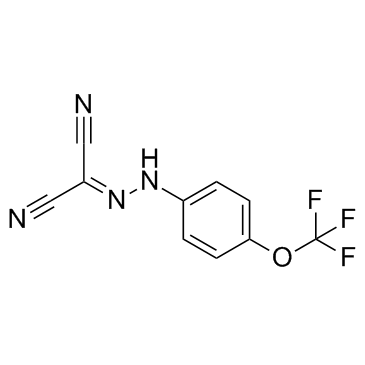370-86-5
| Name | carbonyl cyanide p-trifluoromethoxyphenylhydrazone |
|---|---|
| Synonyms |
2-{2-[4-(trifluoromethoxy)phenyl]hydrazono}malononitrile
2-[[4-(trifluoromethoxy)phenyl]hydrazinylidene]propanedinitrile Propanedinitrile, 2-[2-[4-(trifluoromethoxy)phenyl]hydrazinylidene]- FCCP,Mesoxalonitrile 4-trifluoromethoxyphenylhydrazone Carbonyl cyanide 4-(trifluoromethoxy)phenylhydrazone Carbonyl Cyanide p-Trifluoromethoxyphenylhydrazone {2-[4-(trifluoromethoxy)phenyl]hydrazinylidene}propanedinitrile EINECS 206-730-8 {[4-(Trifluoromethoxy)phenyl]hydrazono}malononitrile MFCD00009699 FCCP |
| Description | FCCP is an uncoupler of oxidative phosphorylation in mitochondria. |
|---|---|
| Related Catalog | |
| In Vitro | FCCP (5 μM) results in a concentration-dependent decrease in Aβ and APPsβ production in K695sw cells. FCCP inhibits processing of wild-type APP. FCCP does not alter cellular ATP levels at any of the concentrations measured. The effects of FCCP on APP catabolism are independent of secondary effects on oxidative phosphorylation or the result of reduced cell viability. FCCP (5 μM or 500 nM), baf A1, and NH4Cl induce changes in Tf-Tx and Tf-F cellular fluorescence in K695 cells[1]. FCCP (200 nM) protects and enhances the follicle integrity in cat ovarian tissue during short-term in vitro culture. But FCCP does not appear to exert a beneficial or detrimental effect during ovarian tissue cryopreservation[2]. |
| Cell Assay | K695sw cells are maintained and exposed to vehicle or various concentrations of FCCP as mentioned above with the exception that cells are plated at a density of 20,000 cells per well in 96-well plates. Twenty-four hours after plating, cells are exposed to various treatments in Dulbecco’s modified Eagle’s medium supplemented with sodium pyruvate (1 mM). At the same time as drug exposures, YO-PRO (4 μM) is added to each well, and its uptake is quantified every 30 min for 1 day at 37°C using a Cytofluor 2350 fluorometric plate reader. As a positive control, all wells are exposed to 0.1% Triton X-100 at the end of the experiment[1]. |
| References |
| Density | 1.3±0.1 g/cm3 |
|---|---|
| Boiling Point | 293.3±50.0 °C at 760 mmHg |
| Melting Point | 174-175ºC (dec.)(lit.) |
| Molecular Formula | C10H5F3N4O |
| Molecular Weight | 254.168 |
| Flash Point | 131.2±30.1 °C |
| Exact Mass | 254.041550 |
| PSA | 81.20000 |
| LogP | 3.65 |
| Vapour Pressure | 0.0±0.6 mmHg at 25°C |
| Index of Refraction | 1.522 |
| Storage condition | 2-8°C |
| Water Solubility | acetone: 20 mg/mL, clear, very deep greenish yellow |
| Symbol |

GHS06 |
|---|---|
| Signal Word | Danger |
| Hazard Statements | H301-H317-H413 |
| Precautionary Statements | P280-P301 + P310 |
| Personal Protective Equipment | Eyeshields;Faceshields;Gloves;type P2 (EN 143) respirator cartridges |
| Hazard Codes | T: Toxic;Xi: Irritant; |
| Risk Phrases | R25 |
| Safety Phrases | 36/37-45 |
| RIDADR | UN 2811 6 |
| WGK Germany | 3 |
| RTECS | FG5775000 |
| Packaging Group | II |
| Hazard Class | 6.1(a) |
| HS Code | 2928000090 |
| HS Code | 2928000090 |
|---|---|
| Summary | 2928000090 other organic derivatives of hydrazine or of hydroxylamine VAT:17.0% Tax rebate rate:9.0% Supervision conditions:none MFN tariff:6.5% General tariff:20.0% |


